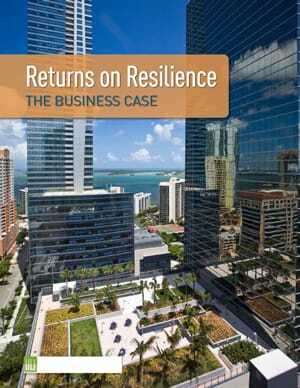As climate change poses greater financial risks to real estate in the form of near-term extreme weather events and longer-term impacts like sea-level rise, developers and owners are increasingly investing in new infrastructure and technologies, innovative design and construction methods, and other resilience strategies not only to protect their properties, but also to create value for their developments, according to Returns on Resilience: The Business Case, released today by the Urban Land Institute (ULI).
The report was developed by the Institute’s Urban Resilience Program in partnership with the Responsible Property Investment Council (RPIC), a group of ULI members representing a wide range of land use disciplines who seek to accelerate the adoption of so-called triple-bottom-line principles, where environmental sustainability and social equity are pursued in tandem with strong financial returns.
As part of the Institute’s Center for Sustainability, ULI’s Urban Resilience Program helps communities prepare for increased climate risk in ways that foster a quicker, safer return to normalcy after an event and an ability to thrive going forward. The Kresge Foundation provided funding for Returns on Resilience.
The report highlights several projects that were designed to physically and financially perform well in the face of climate threats unique to their locations. The projects represent a range of property types across three U.S. regions with diverse geographies and challenges: the northeastern coast, the Caribbean and tropical southeastern coast, and the south-central and western United States. The specific threats to properties discussed in the case studies include hurricanes, tropical storms, sea-level rise, storm surges, coastal flooding, drought, wind, and extreme temperatures. The case studies explain each development team’s motivation and analysis behind their resilience-related investments, while also detailing current or anticipated returns on these investments.
“Each case study reflects an awareness on the part of property developers, owners, and investors that incorporating resilience is a strategic decision that both creates value and minimizes exposure at the asset level and at the enterprise level,” said RPIC chair Molly McCabe, president and founder of HaydenTanner LLC, an investment advisory firm focused on sustainable development. “Development approaches that anticipate future risks and integrate resilience planning into the design, construction, and maintenance of properties simply make good business sense. They result in assets—and ultimately, entire communities—that have enduring value to developers, investors, and the people who live in them.”
The report notes that returns on resilience investments come in many forms, including bottom-line boosting measures such as utility cost savings and reduced insurance premiums. Value can also be generated in the form of business continuity, loss prevention and mitigation, and brand/image preservation and enhancement during extreme weather events.
Consumer awareness of climate risks and a preference for safe and sustainable homes, offices, and vacation destinations can create a competitive advantage for properties designed to withstand extreme weather and adapt to climate change.
In addition, when pursued together, sustainability and resilience measures can yield the higher returns that developers, owners, and investors are looking for, the report notes. “The case studies illustrate that sustainability efforts intended to minimize negative impacts on the natural environment and manage natural resources more efficiently complement resilience planning,” said Sarene Marshall, executive director of ULI’s Center for Sustainability. “When resilience efforts are planned in tandem with sustainability measures, the results are likely to lead to success in better financing, faster and higher lease rates, more competitive insurance premiums, lower utility costs, and greater returns on investments.”
The projects and locations featured in the report with the climate risks they face include the following:
- Spaulding Rehabilitation Hospital, Boston:
Coastal storms, storm surge, and sea-level rise.
- 6 New Street, a residential, mixed-use building in Boston:
Coastal storms, storm surge, and sea-level rise.
- Arverne by the Sea, a residential, mixed-use, transit-oriented development in the New York City borough of Queens:
Coastal storms, storm surge, and sea-level rise.
- 1450 Brickell, an office, mixed-use building in Miami:
Hurricanes, tropical storms, and storm surge.
- Ritz-Carlton, Grand Cayman, a resort and residential property in Grand Cayman, the Cayman Islands:
Hurricanes, tropical storms, and storm surge.
- Gaylord Opryland/Grand Ole Opry, a resort and entertainment complex located in Nashville:
River flooding.
- The Residences at La Cantera, a master-planned community in San Antonio, Texas:
Drought and heat.
- ENR2, an academic building at the University of Arizona in Tucson, Arizona:
Drought, heat, and flooding.
- KB Home Double ZeroHouse, a residential product in Lancaster, California:
Drought and heat.


![Western Plaza Improvements [1].jpg](https://cdn-ul.uli.org/dims4/default/15205ec/2147483647/strip/true/crop/1919x1078+0+0/resize/500x281!/quality/90/?url=https%3A%2F%2Fk2-prod-uli.s3.us-east-1.amazonaws.com%2Fbrightspot%2Fb4%2Ffa%2F5da7da1e442091ea01b5d8724354%2Fwestern-plaza-improvements-1.jpg)


